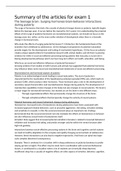Samenvatting
Adolescent development exam 1: Summary of the articles
- Instelling
- Universiteit Utrecht (UU)
Summary of the following articles are included: - Peper, J.S., & Dahl, R.E. (2013). The Teenage Brain: Surging hormones--Brain-behavior interactions during puberty. Current Directions in Psychological Science, 22, 134-139. doi: 10.1177/ - Ge, X., & Natsuaki, M.N. (2009). In search of explanations f...
[Meer zien]




